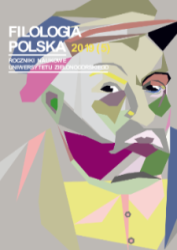Communication strategies in the service of the past apotheosis in Zofia Bukowiecka’s historical prose from the partitions period
Keywords
Abstract
The aim of the sketch is to identify writing strategies and the repertoires of linguistic means used in the apotheosizing description of the state that emerges from Zofia Bukowiecka’s historical prose. Creation of a laudatory vision of Poland’s past (in accordance with the guidelines of the era) is created by Z. Bukowiecka purposively and is of an educational, comforting, and finally – the most importantly – formative nature, i.e. it aims to awaken patriotic attitudes in a nation which was deprived of the state. A look at Zofia Bukowiecka’s texts from the perspective of linguistic pragmatics allowed us to distinguish several writing strategies that serve to implement the apotheosis of the past vision. These are the idyllic stylization of the landscape, the amelioration of the state, the glorification of the rulers and the magnification of the nation. Particularly frequently used linguistic means (from various levels of language and text organization) implementing particular strategies were: accumulation, hyperbole, contrast, evaluative vocabulary, the topos of becoming silent, brutalization, argumentum ad verecundiam.
References
ŹRÓDŁA I SKRÓTY
(H) – Bukowiecka Z., Mała historya Polski, Kraków 1906, [online] [https://polona.pl/item/mala-historya-polski,NDczNw/1/#info:metadata].
[Google Scholar]
(J) – Bukowiecka Z., Jak Polska za Jagiellonów urosła od morza do morza. Opowiadania, Warszawa 1909, [online] [doccontent].
[Google Scholar]
(P) – Bukowiecka Z., Jak Piastowie budowali Polskę. Opowiadania, Warszawa 1910, [online] [https://polona.pl/item/jak-piastowie-budowali-polske-opowiadania,MTEwMjA5MzE/6/#info:metadata].
[Google Scholar]
LITERATURA CYTOWANA
Barycz H., Szlakami dziejopisarstwa staropolskiego. Studia nad historiografią w. XVI-XVIII, Wrocław 1981.
[Google Scholar]
Chwalba A., Metodologiczne aspekty badań nad historią Polski w XIX wieku, „Prace Komisji Historii Nauki Polskiej Akademii Umiejętności” 2004, t. 6.
[Google Scholar]
Hawrysz M., Językowa kreacja wizerunku władców w średniopolskim piśmiennictwie historiograficznym – przyczynek do badań dyskursu tożsamościowego, „Studia Językoznawcze. Synchroniczne i Diachroniczne Aspekty Badań Polszczyzny” 2015, t. 14.
[Google Scholar]
Hawrysz M., Kobiecy dyskurs niepodległościowy – źródła do badań, [w:] Zielonogórskie seminaria językoznawcze 2018. Dyskursy o przeszłości. Dyskursy w przeszłości, red. M. Hawrysz, M. Jurewicz-Nowak, I. Kotlarska, Zielona Góra 2019, s. 49-63.
[Google Scholar]
Kaniowska-Lewańska I., Literatura dla dzieci i młodzieży do roku 1864. Zarys monograficzny. Materiały, Warszawa 1980.
[Google Scholar]
Kieniewicz S., Historia a świadomość narodowa, Warszawa 1982.
[Google Scholar]
Kisielewska J., Z Konarskich Zofja Bukowiecka. Życie i prace, Warszawa 1923.
[Google Scholar]
Kuliczkowska K., Literatura dla dzieci i młodzieży w latach 1864-1918. Zarys monograficzny. Materiały, Warszawa 1981.
[Google Scholar]
Mądrowska E., „Domini naturales”. Portrety polskich władców w „Chronicon Polonorum” mistrza Wincentego, Bydgoszcz 2010.
[Google Scholar]
Puzynina J., Język wartości, Warszawa 1992.
[Google Scholar]
Słownik łacińsko-polski, red. M. Plezia, Warszawa 1998.
[Google Scholar]
Preview
Downloads
Published
How to Cite
Issue
Section
Categories
Copyright & License

This work is licensed under a Creative Commons Attribution-NonCommercial-NoDerivatives 4.0 International License.
Copyrights (a). In principle, authors who are not employed by the University of Zielona Góra retain the copyright, including publishing rights to the articles, without restrictions.
Copyrights (b). In principle, authors who are employed by the University of Zielona Góra, do not retain the copyright, including publishing rights to the articles. In such cases the copyright holder is the University of Zielona Góra.
Print ISSN
2450-3584-
Abstract172











































